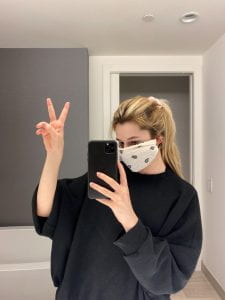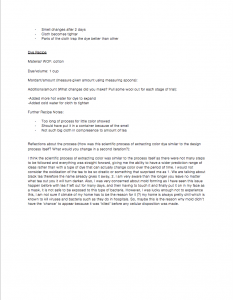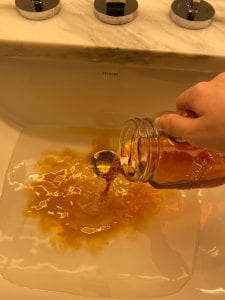Natural Dye Protective Mask
#makeitfashion
Dye: a natural or synthetic substance used to add a color to or change the color of something.
During this process I learned how important climate and light might affect how the dye turns out. Dying is something trending right now on social media which I think it is an amazing approach to create a movement of sustainability to society. I think I started this project being very naive as to how cotton might absorb color. I decided to pick this 100% cotton cloth as cotton is a natural, breathable fibre that is absorbent and soft. It is a natural, hypoallergenic fibre and is easy to dye. This is due to its high absorbency rate and its natural whiteness. However, I feel the fact that the climate of my bathroom (being always cold) really affected how perhaps it tighten the cloth’s fibers making it difficult to absorb the dye from the black tea and making it sink better. I was drawn to black tea as it is already something I drink a lot off and it is considered to have high anti-stress levels when consumed. I think that spreading the message of not only using a mask, but finding the right one for you is essential for times like these. We are going to have to spend a long time getting adjusted and incorporating such masks into our everyday, therefore we have to know how our body reacts to it, as it is quite un-natural. The smell of black tea for me really relaxes my senses and lets me think of wearing a mask as less ‘claustrophobic’. When I took the cloth out of the tea, and dried it, the cloth smelled amazing. I was very happy with this result as it was something I was surprised by this as all my attention was focus on how ‘dark’ the cloth would turn for the purpose of the project, however, within the process itself I learned to observe in a more detail way on how to notice change, analyze it, hypothesis about it, and conclude on my finals thoughts backing it up by facts – pictures, notes, etc..
Here we have the lab report:
Process:
100% cotton cloth
2 rubber bands
These products were items I found around my house and decided to give them a second use on how I would regularly use them. Times like these is what make use create, necessity = solutions. I wasn’t able to use a plain simple white cloth, and I haven’t gone outside in a while, so these were the perfect items that fit with what I wanted to do.
As we can see the tea had already turned quite dark, for the dye to be effective enough.
I think I had to take a picture of this as I shows how the black tea dyes the water with a orange/brown color. I would have liked to have a pH measurement as water having a pH of 7 and black tea of 4.9-5.5 would have been a great example of how effective the dye process would be, and taking notes on some scientific evidence for then my evaluation to be more credible and ‘reliable’.
Video of how to make the mask:
What would I change?
I think that the first thing I would change if I was to do this again is to do this in an open space, rather than indoors for several reasons; hygiene, light exposure, air exposure, clarity of product being used, and smell. I have realized by researching about tea how important air exposure can be to the evolvement of such thing, and how this factor will immediately have a domino effect on the product being dyed. Moreover, I realized it was not the most hygienic move to keep the tea and cloth in a sink for 2 days. This can attract bacteria, and then contaminate my skin, clothes, or environment. Also, I would try to dye different products at once to see which one is the best to dye with black tea, as not all fabrics absorb the same way, and although cotton is the best one for this project as the cotton fiber, which retains 24 to 27 times its weight in water, breathes by absorbing and releasing moisture quickly. This absorbent quality makes cotton an easy fabric to dye, rayon can out-do this and it would be very interesting how it would come out. I would also include more types of teas and see which keep their smell, evaporated, or deteriorated by leaving it sink with the water and cloth.







